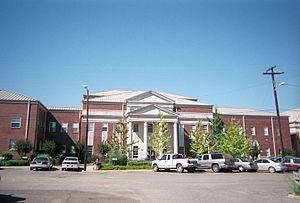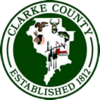Clarke County, Alabama facts for kids
Quick facts for kids
Clarke County
|
||
|---|---|---|

Clarke County Courthouse in Grove Hill
|
||
|
||

Location within the U.S. state of Alabama
|
||
 Alabama's location within the U.S. |
||
| Country | ||
| State | ||
| Founded | December 10, 1812 | |
| Named for | John Clarke | |
| Seat | Grove Hill | |
| Largest city | Jackson | |
| Area | ||
| • Total | 1,253 sq mi (3,250 km2) | |
| • Land | 1,238 sq mi (3,210 km2) | |
| • Water | 14 sq mi (40 km2) 1.1% | |
| Population
(2020)
|
||
| • Total | 23,087 | |
| • Estimate
(2023)
|
22,337 |
|
| • Density | 18.425/sq mi (7.1141/km2) | |
| Time zone | UTC−6 (Central) | |
| • Summer (DST) | UTC−5 (CDT) | |
| Congressional district | 7th | |
|
||
Clarke County is a county located in the southwestern part of the U.S. state of Alabama. As of the 2020 census, the population was 23,087. The county seat is Grove Hill. The county's largest city is Jackson. The county was created by the legislature of the Mississippi Territory in 1812. It is named in honor of General John Clarke of Georgia, who was later elected governor of that state.
The county museum is housed in the Alston-Cobb House in Grove Hill.
Contents
History
Pre-European era
For thousands of years, this area was occupied along the rivers by varying cultures of indigenous peoples. At the time of European encounter, Clarke County was the traditional home of the Choctaw and the Creek people. They traded with the French, who had settlements in Mobile and New Orleans. They also were reached by some English and Scots traders from the British colonies along the Atlantic Coast. After the Louisiana Purchase, they started to establish relations with the United States.
In 1805, by the Treaty of Mount Dexter, the Choctaw conveyed large amounts of land in what is now southeastern Mississippi and southwestern Alabama, including much of the western portion of Clarke County, to the United States for settlement by European Americans.
Modern era
Clarke County was established on December 10, 1812, by the Mississippi Territory. The county had numerous forts, built by settlers for protection during the Creek War (1813–1814). Some of these forts included: Fort Carney, Fort Easley, Fort Glass, Fort Landrum, Fort Madison, Fort Sinquefield, Turner's Fort, and Fort White. The first county seat was Clarkesville, founded in 1820. The seat was moved to Macon, later renamed Grove Hill, in 1831.
In 1883, the U.S. Supreme Court upheld the conviction of Tony Pace and Mary Cox for interracial dating, in Pace v. Alabama. That precedent was subsequently overturned. In 1892, Clarke County was the scene of a violent confrontation around economic divides that later became known as the Mitcham War.
Salt production
Clarke County is home to numerous salt springs. These springs have been used as a source for salt as early as the Mississippian period in 1100 AD. During the Civil War, the county was notable for its salt production due to the naval blockade of southern ports. The Commissioner's Court of Clarke County appropriated $1500 in 1862 for the manufacturing of salt at the salt springs and the State of Alabama operated multiple salt works during the Civil War. These salt works had housing for workers, hospitals, and cemeteries and the salt was produced for military and civilian use. Forts were built at Oven Bluff (Fort Sidney Johnston) and Carney Bluff (Fort Gullett) to protect the salt works and the approach up the Tombigbee River while an additional fort was built at Choctaw Bluff (Fort Stonewall) to protect any advance up the Alabama River.
Geography
According to the United States Census Bureau, the county has a total area of 1,253 square miles (3,250 km2), of which 1,238 square miles (3,210 km2) is land and 14 square miles (36 km2) (or 1.1%) is water. It is the third-largest county in Alabama by land area and the fourth-largest by total area.
Major highways
Adjacent counties
- Marengo County (north)
- Wilcox County (northeast)
- Monroe County (east)
- Baldwin County (south)
- Washington County (southwest)
- Choctaw County (northwest)
Demographics
| Historical population | |||
|---|---|---|---|
| Census | Pop. | %± | |
| 1820 | 5,839 | — | |
| 1830 | 7,595 | 30.1% | |
| 1840 | 8,640 | 13.8% | |
| 1850 | 9,786 | 13.3% | |
| 1860 | 15,049 | 53.8% | |
| 1870 | 14,663 | −2.6% | |
| 1880 | 17,806 | 21.4% | |
| 1890 | 22,624 | 27.1% | |
| 1900 | 27,790 | 22.8% | |
| 1910 | 30,987 | 11.5% | |
| 1920 | 26,409 | −14.8% | |
| 1930 | 26,016 | −1.5% | |
| 1940 | 27,636 | 6.2% | |
| 1950 | 26,548 | −3.9% | |
| 1960 | 25,738 | −3.1% | |
| 1970 | 26,724 | 3.8% | |
| 1980 | 27,702 | 3.7% | |
| 1990 | 27,240 | −1.7% | |
| 2000 | 27,867 | 2.3% | |
| 2010 | 25,833 | −7.3% | |
| 2020 | 23,087 | −10.6% | |
| 2023 (est.) | 22,337 | −13.5% | |
| U.S. Decennial Census 1790–1960 1900–1990 1990–2000 2010–2020 |
|||
2020 Census
| Race / Ethnicity (NH = Non-Hispanic) | Pop 2000 | Pop 2010 | Pop 2020 | % 2000 | % 2010 | % 2020 |
|---|---|---|---|---|---|---|
| White alone (NH) | 15,519 | 13,943 | 11,970 | 55.69% | 53.97% | 51.85% |
| Black or African American alone (NH) | 11,918 | 11,280 | 10,223 | 42.77% | 43.67% | 44.28% |
| Native American or Alaska Native alone (NH) | 61 | 96 | 74 | 0.22% | 0.37% | 0.32% |
| Asian alone (NH) | 45 | 74 | 91 | 0.16% | 0.29% | 0.39% |
| Pacific Islander alone (NH) | 1 | 4 | 1 | 0.00% | 0.02% | 0.00% |
| Other race alone (NH) | 10 | 9 | 37 | 0.04% | 0.03% | 0.16% |
| Mixed race or Multiracial (NH) | 133 | 156 | 485 | 0.48% | 0.60% | 2.10% |
| Hispanic or Latino (any race) | 180 | 271 | 206 | 0.65% | 1.05% | 0.89% |
| Total | 27,867 | 25,833 | 23,087 | 100.00% | 100.00% | 100.00% |
As of the 2020 United States census, there were 23,087 people, 9,090 households, and 5,662 families residing in the county.
2010
According to the 2010 United States census:
- 54.5% White
- 43.9% Black
- 0.4% Native American
- 0.3% Asian
- 0.0% Native Hawaiian or Pacific Islander
- 0.7% Two or more races
- 1.0% Hispanic or Latino (of any race)
2000
As of the census of 2000, there were 27,867 people, 10,578 households, and 7,700 families residing in the county. The population density was 22 people per square mile (8.5 people/km2). There were 12,631 housing units at an average density of 10 units per square mile (3.9 units/km2). The racial makeup of the county was 55.94% White, 43.02% Black or African American, 0.22% Native American, 0.16% Asian, 0.16% from other races, and 0.49% from two or more races. Nearly 0.65% of the population were Hispanic or Latino of any race.
There were 10,578 households, out of which 35.40% had children under the age of 18 living with them; 53.90% were married couples living together, 15.70% had a female householder with no husband present, and 27.20% were non-families. Nearly 25.50% of all households were made up of individuals, and 11.90% had someone living alone who was 65 years of age or older. The average household size was 2.60, and the average family size was 3.13.
In Clarke County, the population was spread out, with 28.00% under the age of 18, 8.50% from 18 to 24, 27.50% from 25 to 44, 22.50% from 45 to 64, and 13.50% who were 65 years of age or older. The median age was 36 years. For every 100 females, there were 89.70 males. For every 100 females age 18 and over, there were 84.60 males.
The median income for a household in the county was $27,388, and the median income for a family was $34,546. Males had a median income of $34,111 versus $19,075 for females. The per capita income for the county was $14,581. About 18.10% of families and 22.60% of the population were below the poverty line, including 29.60% of those under age 18 and 23.80% of those age 65 or over.
Education
Clarke County contains two public school districts. There are approximately 3,400 students in public PK-12 schools in Clarke County.
Districts
School districts include:
- Clarke County School District
- Thomasville City School District
Communities
Cities
Towns
- Coffeeville
- Fulton
- Grove Hill (county seat)
Census Designated Places
Unincorporated communities
Former communities
Notable people
- Loraine Bedsole Bush Tunstall (1881-1953), social reformer
- Martha Loftin Wilson (1834–1919), missionary worker, journal editor, heroine of the American Civil War
See also
 In Spanish: Condado de Clarke (Alabama) para niños
In Spanish: Condado de Clarke (Alabama) para niños


